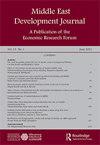Regional efficiency of healthcare services in Saudi Arabia
IF 0.8
Q4 DEVELOPMENT STUDIES
引用次数: 24
Abstract
ABSTRACT This study aims to estimate the regional efficiency of healthcare services in Saudi Arabia. A non-parametric methodology, data envelopment analysis (DEA), is applied to evaluate the relative efficiency of 13 Saudi regions in 2014 by using multiple regional inputs and outputs to characterize healthcare provision. This study provides a unique measurement of Saudi regional efficiency since most of the previous studies that applied DEA in Saudi Arabia focused on public hospitals or primary medical services, which work under the supervision of the Ministry of Health. This is one of the first studies in developing and Arab countries in general, and in Saudi Arabia in particular, which focuses on an interregional level, as it divides each region into public and private sectors. The empirical results show that efficiency differs across the selected regions and between the private and public sectors. In general, less developed regions show a relatively high level of efficiency whereas others, such as Makkah and the Eastern regions, seem to be the least efficient regions in both sectors. The study revealed that the Riyadh region, which employs a disproportionately large amount of health resources in comparison with other regions, is efficient in both sectors. The empirical study also finds evidence of the potential to improve health outcomes by ensuring a sufficient level of healthcare resources in the inefficient regions that are lagging behind significantly. Finally, in some regions the public sector was efficient whereas the private sector was not, and vice versa.沙特阿拉伯医疗服务的区域效率
摘要本研究旨在评估沙特阿拉伯医疗服务的区域效率。采用数据包络分析(DEA)这一非参数方法,通过使用多个地区的投入和产出来表征医疗服务的提供,对2014年沙特13个地区的相对效率进行了评估。这项研究提供了一种独特的沙特区域效率衡量方法,因为之前在沙特阿拉伯应用DEA的大多数研究都集中在公立医院或初级医疗服务上,这些医院或服务在卫生部的监督下工作。这是在发展中国家和阿拉伯国家,特别是在沙特阿拉伯进行的首批研究之一,该研究侧重于区域间层面,因为它将每个区域划分为公共和私营部门。实证结果表明,所选地区以及私营和公共部门的效率不同。总的来说,欠发达地区的效率相对较高,而其他地区,如麦加和东部地区,似乎是这两个部门效率最低的地区。研究表明,与其他地区相比,利雅得地区使用了不成比例的大量卫生资源,在这两个部门都很有效。实证研究还发现,通过确保在严重落后的低效地区提供足够的医疗资源,有可能改善健康状况。最后,在一些地区,公共部门效率很高,而私营部门则不然,反之亦然。
本文章由计算机程序翻译,如有差异,请以英文原文为准。
求助全文
约1分钟内获得全文
求助全文

 求助内容:
求助内容: 应助结果提醒方式:
应助结果提醒方式:


